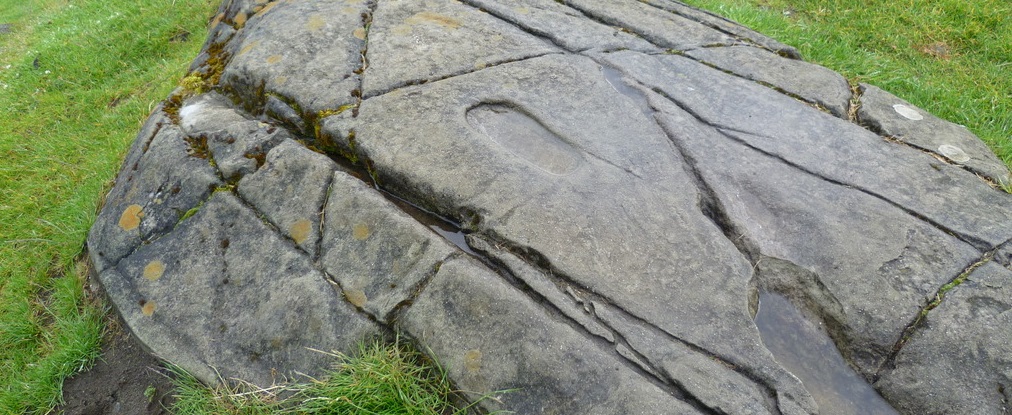Trinity Public Affairs and Communications RE: Seán Duffy, Professor of Medieval History Dear Paul, That is fine if you would please credit Trinity College Dublin as well as the author, thanks for your interest.Best regards, Katie
Crowning of Ireland’s Last, Scottish High King By kind permission – Seán Duffy, Professor of Medieval History and Trinity College Dublin
The Irish and the Scots may be deadly enemies when Scotland vies with the Republic in rugby or football. But it was all so very different exactly 700 odd years ago. The year was 1315 and, yes, there was a life-and-death struggle underway involving the Scots and Irish but, in this earlier, real-life struggle, not only were they the very best of friends – and their common enemy? Surprise, surprise, the English – but the Irish had just set up a Scotsman as their high-king. The Scot in question – who would be Ireland’s last high-king – was the younger brother of Robert the Bruce, fresh from his great victory over the English at Bannockburn. It may seem strange to us now that the Irish should choose a man from Scotland to follow in the footsteps of Brian Boru, but it only goes to show how closely entwined the Irish and the Scots were in medieval times. The very name ‘Scotland’ – from Scotia, the ‘land of the Scoti’ ‘ is an ever-present reminder of that connection, because, in the Latin of the early Middle Ages, a Scotus was an Irishman, a Gael, and the homeland of the Scoti was Ireland. It was only when an Irish dynasty – Dál Riata of Antrim – gained ascendancy in northern Britain, that it gradually became known as the land of the Scoti and therefore ‘Scotland’ was born. But the idea that the Scots and Irish were a single people lasted long after Scotland began to emerge as a separate kingdom. Back in the year 1005, shortly after he became high-king of Ireland, Brian Boru adopted the title Imperator Scotorum, ‘Emperor of the Scoti’ and there is evidence to suggest that he saw himself, not just as overlord of all Ireland, but of all the Gaels, including those who lived in a kind of permanent exile across the North Channel in Scotland. That is why, when Robert Bruce seized the throne of Scotland in defiance of the English in 1306, but was forced into exile on Rathlin Island off the Antrim coast, he wrote a letter to “his friends”, the Irish, in which he reminded them that they and the Scots “stem from one seed of birth”, share “a common language and common customs”, and offered a permanent alliance against the English, their would-be conquerors, “so that our nation (nostra natio)” – one nation, the Scots and Irish – “may recover her ancient freedom”.
It was that alliance that culminated in the inauguration of his brother Edward as high-king of Ireland in the summer of 1315. And although the Bruce family was, on the surface, thoroughly Anglo-Norman, Edward and Robert Bruce were of Gaelic extraction on their mother’s side, and had close connections with the Gaelic world of Western Scotland and the Hebrides – it was even said that the young Edward had been fostered in Ireland with his leading Irish ally, Domhnall O’Neill, king of Ulster. And there may have been ties of blood between Robert the Bruce and the O’Neills. During Edward Bruce’s brief reign as king of Ireland, O’Neill wrote to the Pope to try to win papal backing for this most audacious attempt to end English rule in Ireland. This extraordinary letter (usually called the 1317 Remonstrance) is one of the earliest and most potent statements of Irish national identity and of opposition to the English who, O’Neill says, “have striven with all their might and with every treacherous trick in their power, to wipe our nation out entirely”. In it, he refers to Scotland in Latin as Scotia Minor and to Ireland as Scotia Major, and talks about Edward and Robert Bruce as being “sprung from our noblest ancestors”. So here we see Edward and Robert Bruce being depicted as, in effect, Irish. Edward Bruce’s reign as high-king of Ireland did not last long. In October 1318, as he marched south from his power base in Ulster to try to overrun the lands of the English colonists in the hinterland of Dublin (what would later be known as the Pale), he risked an open battle with an English army just north of Dundalk at Faughart, lost his life, and with it his Irish kingdom. He was an unlucky general. His invasion coincided with the Great European Famine (1315-17) and, as appalling weather and three consecutive harvest failures brought widespread hardship, disillusionment set in among his Irish supporters, the annals ruefully commenting that during his reign “falsehood and famine and homicide filled the country, and undoubtedly men ate each other in Ireland.” But his inauguration as Ireland’s last ever high-king, exactly 700 years ago this year, was living proof of a legacy of Irish links with Scotland which deserves to be remembered and cherished.
An interesting read, I am grateful to the folks in Ireland. PAUL MCLEAN
……………………………………………………………..
A Not-So-Brief History of Scottish Independence
Many thanks to the Smithsonian and Ben Johnson for Historic U.K.
When the Roman Empire’s armies, emboldened by their successful conquest of southern Britain, arrived in Scotland during the first century A.D., they were met by tribes who quickly “turned to armed resistance on a large scale,” according to Roman historian Tacitus. Hadrian’s Wall Outmatched by the Romans’ “highly disciplined war machine,” writes Ben Johnson for Historic U.K., the locals, called Caledonians by the Romans, resorted to guerrilla tactics, carrying out night-time raids on unsuspecting Roman forts. Although the Scottish tribes suffered a devastating defeat at the Battle of Mons Graupius in 83 A.D., the skirmish marked the Romans’ furthest advance into Scotland, and over the next several centuries, Rome failed to secure additional territory in the region. In northern Scotland, meanwhile, a tribe known as the Picts gained traction and started carrying out border raids at the far reaches of Hadrian’s Wall. By 212 A.D., the Romans had all but abandoned Scotland, and in 410, they withdrew from Britain entirely.
The next wave of outsiders to stake a claim on Scotland were the Vikings, who launched their first attacks on the British Isles during the late eighth century. These Scandinavians didn’t venture to new lands solely in search of plunder. Many settled down, making homes for themselves in places like Ireland and Scotland and building ties with existing communities. Still, the Vikings’ intentions weren’t entirely noble, and in the mid-ninth century, a tribal leader named Kenneth MacAlpin united the famously fragmented Scottish clans in the fight against the foreign invaders. In doing so, he became arguably the first ruler of the Kingdom of Scotland, founding a dynasty that would endure for centuries
The Wars of Scottish Independence. During the medieval period, England started treating its northern neighbour much like a feudal territory. In response, Scottish patriots banded together under William Wallace, the freedom fighter forever (erroneously) cemented in popular imagination as a blue paint-covered kilt-wearer. Wallace and his men won a decisive victory at the Battle of Stirling Bridge in September 1297 but lost momentum and, in July 1298, suffered a devastating defeat at the Battle of Falkirk. After Falkirk, Wallace went on the run. He evaded the English for years but was captured and executed in August 1305. As Wallace’s influence faded, Robert the Bruce seized power. Following years of fighting, most famously at the Battle of Bannockburn in 1314, Bruce convinced England to recognize Scotland’s independence, bringing the First War of Scottish Independence to a close in 1328. Though a Second War of Scottish Independence began soon after Bruce’s death, it petered out when England’s focus shifted to the Hundred Years’ War against France. In Scottish lore, Wallace and Bruce are the figures around whom “pretty much everybody inside the [modern] nationalist movement is able to unite behind,” says Curtice. “Bannockburn is probably the most iconic piece of anti-English history.”
The Stuart dynasty and the English Civil War. When Elizabeth I died childless in 1603, an opportunity arose for unification between the neighbouring nations. The deceased monarch’s distant cousin James VI of Scotland, son of Mary, Queen of Scots, took the English and Irish thrones as James I, becoming the first monarch to unite the three nations under one crown. His accession, in the words of University of Glasgow historian Karin Bowie, was a “dynastic accident” with longstanding consequences. Though James hoped to unite England, Ireland and Scotland in one kingdom, his vision proved unpopular, and over the coming century, civil war and rebellion ran rampant in all three kingdoms. James’ son Charles I showed even less foresight than his father, and his tyrannical tendencies eventually cost him both the crown and his head. In the ensuing English Civil War, Scots fervently backed the forces of Charles II, who upon retaking the throne after the 1660 death of Lord Protector Oliver Cromwell, was hailed as king of England, Scotland and Ireland. Charles was succeeded by his brother James II, who in turn lost the throne to Protestant William and Mary during the bloodless Glorious Revolution of 1688. (As the Catholic king of a largely Protestant country, James, whose Latin name inspired his supporters’ classification as Jacobites, alienated his subjects by prosecuting Anglican bishops and suspending the Scottish and English Parliaments after they refused to repeal anti-Catholic legislation.) Mary’s sister Anne inherited the throne following the couple’s untimely deaths, ushering in what would prove to be a decisive new era in Scottish-Anglican relations.
The Acts of Union and the Jacobite revolts On May 1, 1707, England and Scotland officially united, becoming “One Kingdom by the Name of Great Britain.” According to Bowie, two main factors precipitated the arrival of this long-portended union: Scots were dissatisfied with “how they were being governed within the union” of crowns, and the monarchy created by the Glorious Revolution was “precarious,” under constant threat of rebellion by the Jacobite supporters of the deposed James II. The treaty passed by both nations’ parliaments lent Scotland economic security and access to England’s colonial trade network; meanwhile, a provision that excluded all Catholics—namely, James’ exiled descendants—from the royal succession gave England a safeguard against the Jacobites and Catholic France. With the passage of the Acts of Union, coinage, taxes and trade were standardized across Great Britain. Scotland retained its legal, religious and educational systems but joined the main British Parliament, albeit with a disproportionately low number of representatives. The union of these two oft-warring countries proved predictably unpopular. As poet Robert Burns later observed, many Scots believed their representatives had been “bought and sold for English gold.” Unionists tended to be fairly well-to-do and highly educated, but they met a “huge amount of resistance” from Scottish nationalists who shared a deep-seated distrust of England.
By 1715, discontent over the union’s adverse political and economic effects was widespread enough to spark a Jacobite-led rebellion. According to the U.K. Parliament portal, the Jacobites painted themselves as “defenders of Scottish liberties,” pledging to repeal the union and restore Scotland’s parliament, but remained chiefly concerned with restoring the crown to the descendants of James II. Though George I was able to quell the 1715 rebellion, the Jacobite cause remained a strong force in the Scottish Highlands, and in 1745, a second revolt centred on Prince Charles Edward Stuart, better known as Bonnie Prince Charlie or the Young Pretender, broke out. Following the revolt’s failure, the British government implemented harsh policies aimed at dismantling the Highlands’ clan system and eliminating the Jacobite cause once and for all.

